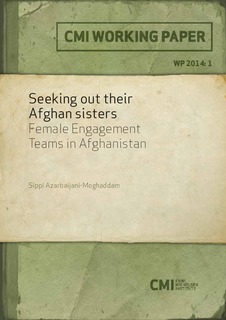| dc.contributor.author | Azarbaijani-Moghaddam, Sippi | |
| dc.date.accessioned | 2018-01-04T08:18:56Z | |
| dc.date.available | 2018-01-04T08:18:56Z | |
| dc.date.issued | 2014-03-25 | |
| dc.identifier | oai:www.cmi.no:5096 | |
| dc.identifier.citation | Bergen: Chr. Michelsen Institute (CMI Working Paper WP 2014:1) 62 p. | |
| dc.identifier.isbn | 978-82-8062-478-9 | |
| dc.identifier.issn | 0804-3639 | |
| dc.identifier.uri | http://hdl.handle.net/11250/2474930 | |
| dc.description.abstract | Almost a decade after the 2001 intervention by the United States and its allies in Afghanistan, women were once again taking centre stage in NATO planning. With a new counter-insurgency (COIN) strategy in play, gaining civilian support became crucial. In this context, Afghan women came to be seen as influential matriarchal figures and potential allies who could help turn the tide against the Taliban and other insurgents.
Under the overall command of ISAF (the International Security Assistance Force) the US and the UK set up Female Engagement Teams (FET), consisting of international military women tasked to build rapport, offer support and gain the allegiance of Afghan women and their families. This report follows the course of FETs in southern Afghanistan during the period of 2010 to early 2012. It critically examines the assumptions underpinning the teams and why they produce so few results. | |
| dc.language.iso | eng | |
| dc.publisher | Chr. Michelsen Institute | |
| dc.relation | CMI Working Paper | |
| dc.relation | WP 2014:1 | |
| dc.relation.ispartof | CMI Working Paper | |
| dc.relation.ispartofseries | CMI Working Paper WP 2014:1 | |
| dc.relation.uri | https://www.cmi.no/publications/5096-seeking-out-their-afghan-sisters | |
| dc.subject | Afghanistan | |
| dc.title | Seeking out their Afghan sisters: Female Engagement Teams in Afghanistan | |
| dc.type | Working paper | |
